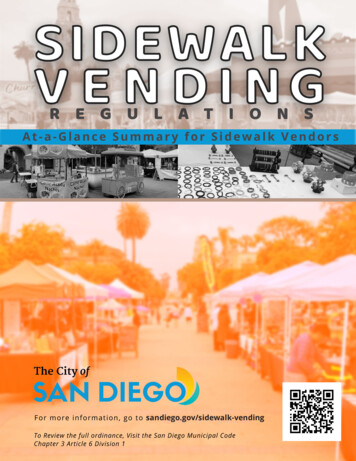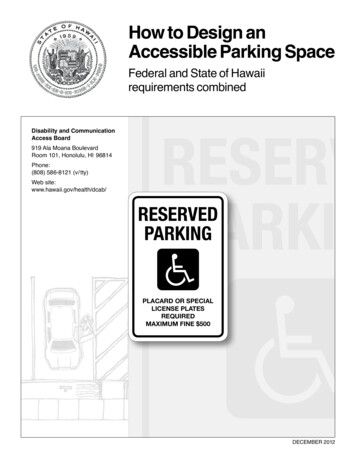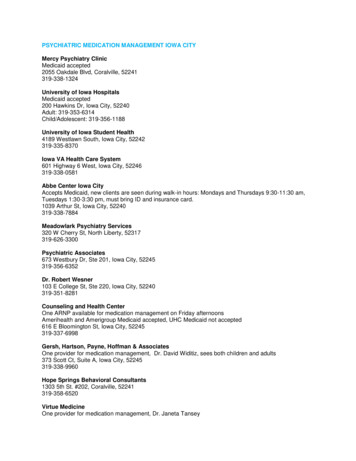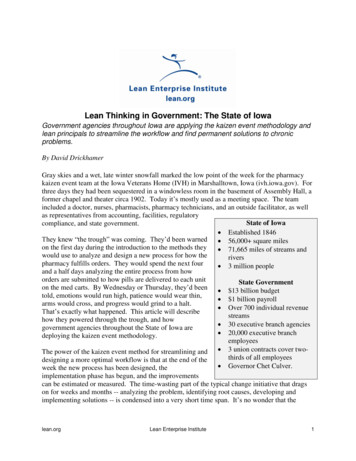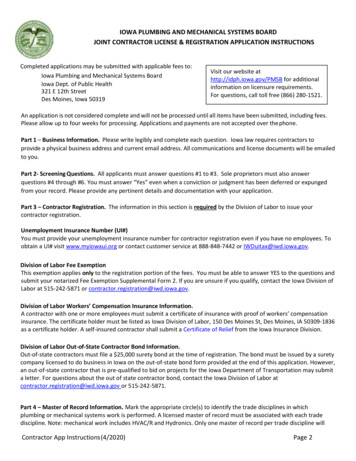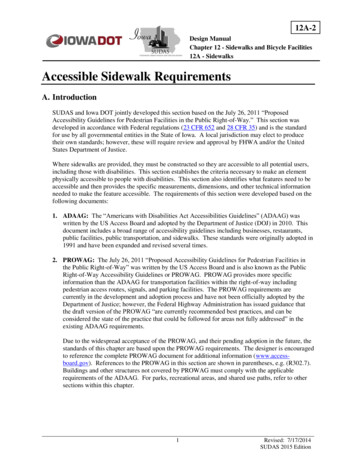
Transcription
12A-2Design ManualChapter 12 - Sidewalks and Bicycle Facilities12A - SidewalksAccessible Sidewalk RequirementsA. IntroductionSUDAS and Iowa DOT jointly developed this section based on the July 26, 2011 “ProposedAccessibility Guidelines for Pedestrian Facilities in the Public Right-of-Way.” This section wasdeveloped in accordance with Federal regulations (23 CFR 652 and 28 CFR 35) and is the standardfor use by all governmental entities in the State of Iowa. A local jurisdiction may elect to producetheir own standards; however, these will require review and approval by FHWA and/or the UnitedStates Department of Justice.Where sidewalks are provided, they must be constructed so they are accessible to all potential users,including those with disabilities. This section establishes the criteria necessary to make an elementphysically accessible to people with disabilities. This section also identifies what features need to beaccessible and then provides the specific measurements, dimensions, and other technical informationneeded to make the feature accessible. The requirements of this section were developed based on thefollowing documents:1. ADAAG: The “Americans with Disabilities Act Accessibilities Guidelines” (ADAAG) waswritten by the US Access Board and adopted by the Department of Justice (DOJ) in 2010. Thisdocument includes a broad range of accessibility guidelines including businesses, restaurants,public facilities, public transportation, and sidewalks. These standards were originally adopted in1991 and have been expanded and revised several times.2. PROWAG: The July 26, 2011 “Proposed Accessibility Guidelines for Pedestrian Facilities inthe Public Right-of-Way” was written by the US Access Board and is also known as the PublicRight-of-Way Accessibility Guidelines or PROWAG. PROWAG provides more specificinformation than the ADAAG for transportation facilities within the right-of-way includingpedestrian access routes, signals, and parking facilities. The PROWAG requirements arecurrently in the development and adoption process and have not been officially adopted by theDepartment of Justice; however, the Federal Highway Administration has issued guidance thatthe draft version of the PROWAG “are currently recommended best practices, and can beconsidered the state of the practice that could be followed for areas not fully addressed” in theexisting ADAAG requirements.Due to the widespread acceptance of the PROWAG, and their pending adoption in the future, thestandards of this chapter are based upon the PROWAG requirements. The designer is encouragedto reference the complete PROWAG document for additional information (www.accessboard.gov). References to the PROWAG in this section are shown in parentheses, e.g. (R302.7).Buildings and other structures not covered by PROWAG must comply with the applicablerequirements of the ADAAG. For parks, recreational areas, and shared use paths, refer to othersections within this chapter.1Revised: 7/17/2014SUDAS 2015 Edition
Chapter 12 - Sidewalks and Bicycle FacilitiesSection 12A-2 - Accessible Sidewalk RequirementsB. Transition PlanThe ADA law passed in 1990 required public entities with more than 50 total employees to develop aformal transition plan identifying the steps necessary to meet ADA accessibility requirements for allpedestrian access routes within their jurisdiction by upgrading all noncompliant features.Recognizing that it would be difficult to upgrade all facilities immediately, the law provided theopportunity to develop a transition plan for the implementation of these improvements. Coveredentities had until 1992 to complete a transition plan. In addition, any local public agency that is arecipient of US DOT funds must have a transition plan. For those agencies that have not completed atransition plan, it is critical that this process be completed. Although the transition plan may cover abroader scope, this section will only cover requirements within the public right-of-way.Key elements of a transition plan include the following: Identifying physical obstacles in the public agency’s facilities that limit the accessibility of itsprograms or activities to individuals with disabilities A detailed description of the methods that will be used to make the facilities accessible A schedule for taking the steps necessary to upgrade pedestrian access in each year following thetransition plan Identification of the individual responsible for implementation of the planThe document: ADA Transition Plans: A Guide to Best Management Practices (NCHRP Project No.20-7 (232)) provides guidance for the development and update of transition plans. The document alsoassists communities in prioritizing required improvements for accessibility.Public entities not required to have a formal transition plan are required to address noncompliantpedestrian access routes.C. DefinitionsAccessible: Facilities that comply with the requirements of this section.Alteration: An alteration is a change that affects or could affect the usability of all or part of abuilding or facility. Alterations of streets, roadways, or highways include activities such asreconstruction, rehabilitation, resurfacing, widening, and projects of similar scale and effect.Alternate Pedestrian Access Route: A route provided when a pedestrian circulation path istemporarily closed by construction, alterations, maintenance operations, or other conditions.Curb Line: A line at the face of the curb that marks the transition between the curb and the gutter,street, or highway.Cross Slope: The grade that is perpendicular to the direction of pedestrian travel.Crosswalk: See pedestrian street crossing.Curb Ramp: A ramp that cuts through or is built up to the curb. Curb ramps can be perpendicular,parallel, or a combination of parallel and perpendicular curb ramps.Detectable Warning: Detectable warnings consist of small, truncated domes built in or applied to awalking surface that are detectable by cane or underfoot. On pedestrian access routes, detectablewarning surfaces indicate the boundary between a pedestrian route and a vehicular route forpedestrians who are blind or have low vision.2Revised: 7/17/2014SUDAS 2015 Edition
Chapter 12 - Sidewalks and Bicycle FacilitiesSection 12A-2 - Accessible Sidewalk RequirementsNew Construction: Construction of a roadway where an existing roadway does not currently exist.Pedestrian Access Route: A continuous and unobstructed path of travel provided for pedestrianswith disabilities within, or coinciding with, a pedestrian circulation path.Pedestrian Circulation Path: A prepared exterior or interior surface provided for pedestrian travelin the public right-of-way.Pedestrian Street Crossing: A marked or unmarked route, providing an accessible path to travelfrom one side of the street to the other. Pedestrian street crossings are a component of the pedestrianaccess route and/or the pedestrian circulation path.Running Slope: The grade that is parallel to the direction of pedestrian travel.PROWAG: The Public Right-of-way Accessibility Guidelines establish the criteria for providing afeature within the public right-of-way that is physically accessible to those with physical disabilities.Scope of the Project: Work that can reasonably be completed within the limits of the project. Thisis not defined by the written project scope; however, it focuses on whether the alteration projectpresents an opportunity to design the altered element, space, or facility in an accessible manner.Structurally Impracticable: Something that has little likelihood of being accomplished because ofthose rare circumstances when the unique characteristics of terrain prevent the incorporation of fulland strict compliance with this section. Applies to new construction only.Technically Infeasible: With respect to an alteration of an existing facility, something that has littlelikelihood of being accomplished because existing structural conditions would require removing oraltering a load-bearing member that is an essential part of the structural frame; or because otherexisting physical or site constraints prohibit modification or addition of elements, spaces, or featuresthat are in full and strict compliance with the requirements of this section. (2010 ADAAG 106.5)Turning Space: An area at the top or bottom of a curb ramp, providing a space for pedestrians tostop, rest, or change direction.D. Applicability1. New Construction: Newly constructed facilities within the scope of the project shall be madeaccessible to persons with disabilities, except when a public agency can demonstrate it isstructurally impracticable to provide full compliance with the requirements of this section.Structural impracticability is limited to only those rare situations when the unique characteristicsof terrain make it physically impossible to construct facilities that are fully compliant. If fullcompliance with this section is structurally impracticable, compliance is required to the extentthat it is not structurally impracticable. [2010 ADAAG 28 CFR 35.151(a)]2. Alterations: Whenever alterations are made to the pedestrian circulation path, the pedestrianaccess route shall be made accessible to the maximum extent feasible within the scope of theproject. If full compliance with this section is technically infeasible, compliance is required tothe extent that it is not technically infeasible. [2010 ADAAG 28 CFR 35.151(b)] Alterationsshall not gap pedestrian circulation paths in order to avoid ADA compliance.3Revised: 7/17/2014SUDAS 2015 Edition
Chapter 12 - Sidewalks and Bicycle FacilitiesSection 12A-2 - Accessible Sidewalk RequirementsResurfacing is an alteration that triggers the requirement for curb ramps if it involves work on astreet or roadway spanning from one intersection to another. Examples include, but are notlimited to, the following treatments or their equivalents: New layer of surface material (asphalt or concrete, including mill and fill) Reconstruction Concrete pavement rehabilitation and reconstruction Open-graded surface course Microsurfacing and thin lift overlays Cape seals (slurry seal or microsurfacing over a new chip seal) In-place asphalt recycling[DOJ/U.S. DOT Glossary of Terms and DOJ/U.S. DOT Technical Assistance; June 28, 2013]Where elements are altered or added to existing facilities, but the pedestrian circulation path isnot altered, the pedestrian circulation path is not required to be modified (R202.1). However,features that are added shall be made accessible to maximum extent feasible. The following areexamples of added features: Installation of a traffic sign does not require sidewalk improvements; however, the signcannot violate the protruding objects requirements. Installation of a traffic or pedestrian signal does not require sidewalk improvements;however, the signal must be accessible. Installation of a bench adjacent to the pedestrian access route would not require sidewalkimprovements, but the bench cannot be placed in a manner that would reduce the sidewalkwidth below the minimum requirement.3. Maintenance: Accessibility improvements are not required for work that is consideredmaintenance. Examples of work that would be considered maintenance include, but are notlimited to, the following items. Painting pavement markings, excluding parking stall delineations Crack filling and sealing Surface sealing Chip seals Slurry seals Fog seals Scrub sealing Joint crack seals Joint repairs Dowel bar retrofit Spot high-friction treatments Diamond grinding Minor street patching (less than 50% of the pedestrian street crossing area) Curb and gutter repair or patching outside the pedestrian street crossing Minor sidewalk repair that does not include the turning space and curb ramps Filling potholesIf a project involves work not included in the list above, or is a combination of severalmaintenance items occurring at or near the same time, the agency administering the project isresponsible for determining if the project should be considered maintenance or an alteration. Ifeither of these two situations is determined to be maintenance, the agency administering theproject must document the reasons for this determination. If the project is defined asmaintenance, federal funding and Farm-to-Market funds cannot be used.4Revised: 7/17/2014SUDAS 2015 Edition
Chapter 12 - Sidewalks and Bicycle FacilitiesSection 12A-2 - Accessible Sidewalk RequirementsWhen a maintenance project modifies a crosswalk, installation of curb ramps at the crosswalks isrecommended, if none already exists. The other accessibility improvements of this section arealso recommended, but not required with such projects.4. Technical Infeasibility: Examples of existing physical or site constraints that may make ittechnically infeasible to make an altered facility fully compliant include, but are not limited to,the following: Right-of-way availability. Right-of-way acquisition in order to achieve full compliance is notmandatory, however, it should be considered. Improvements may be limited to the maximumextent practicable within the existing right-of-way. Underground structures that cannot be moved without significantly expanding the projectscope. Adjacent developed facilities, including buildings that would have to be removed or relocatedto achieve accessibility. Drainage cannot be maintained if the feature is made accessible. Notable natural or historic features that would have to be altered in a way that lessens theiraesthetic or historic value. Underlying terrain that would require a significant expansion of the project scope to achieveaccessibility. Street grades within the crosswalk exceed the pedestrian access route maximum cross slopes,provided an engineering analysis has concluded that it cannot be done without significantlyexpanding the project scope (for example, changing from resurfacing an intersection toreconstructing that intersection).5. Safety Issues: When accessibility requirements would cause safety issues, compliance isrequired to the maximum extent practicable.6. Documenting Exceptions: If the project cannot fully meet accessibility requirements becausethe accessibility improvements are structurally impracticable, technically infeasible, or safetyissues, a document should be developed to describe how the existing physical or site constraintsor safety issues limit the extent to which the facilities can be made compliant. This documentshould identify the specific locations that cannot be made fully compliant and provide specificreasons why full compliance cannot be achieved. It is recommended that this document beretained in the project file. For local agency projects administered through Iowa DOT, an“Accessibility Exceptions Certification” (Form 517118) with supporting documentation shall besigned by a registered professional engineer or landscape architect licensed in the State of Iowaand submitted to the Iowa DOT administering office. The certification shall be as prescribed byIowa DOT Local Systems I.M. 1.080. For Iowa DOT projects, contact the Office of Design,Methods Section.Note: Documenting exceptions does not remove an agency’s responsibility to consider makingaccessibility improvements the next time the facility is altered because physical or site constraintsand safety issues may change over time. The determination of exceptions and correspondingdocumentation needs to be made each time a facility is altered, based on the existing conditionsand the scope of the proposed project.7. Reduction in Access: Regardless of whether the additions or alterations involve themodification of the existing pedestrian circulation path, the resulting work cannot have the resultof reducing the existing level of accessibility below the minimum requirements. For example, theinstallation of a bench cannot have the effect of reducing the width of the pedestrian access routeto 3 feet (4 feet is the minimum). Likewise, the construction of an overlay cannot result in astreet cross slope of more than 5%, nor have a lip at the curb ramp that exceeds 1/2 inch.5Revised: 7/17/2014SUDAS 2015 Edition
Chapter 12 - Sidewalks and Bicycle FacilitiesSection 12A-2 - Accessible Sidewalk RequirementsPedestrian facilities may be removed if they are being re-routed for safety reasons, or terminatedbecause they do not connect to a destination or another pedestrian circulation path.8. Addition of Pedestrian Facilities: If a sidewalk exists on both sides of the street, curb rampsshall be installed on both sides when the street is altered. PROWAG does not requireconstruction of pedestrian facilities where none currently exists, although the jurisdiction’stransition plan may require them.9. Utility Construction: If the pedestrian circulation path is disturbed during utility construction,the requirements of this section and Section 12A-4 shall apply.E. Standards for AccessibilityThe following section summarizes the design standards for the elements of an accessible pedestrianaccess route. The minimum and maximum values stated are taken from the PROWAG. Targetvalues are also provided. Designing features to the target values, rather than the allowable maximumor minimum, allows for appropriate construction tolerances and field adjustment during constructionwhile maintaining compliance with the PROWAG standards.1. General Requirements: These requirements apply to all parts of the pedestrian access route.a. Surfacing: PROWAG requires all surfaces to be firm, stable, and slip resistant (R302.7).All permanent pedestrian access routes, with the exception of some Type 2 shared use paths(see Section 12B-2), shall be paved. When crossing granular surfaced facilities, considerpaving wider than the pedestrian access route; see the shared use path section.b. Vertical Alignment: Vertical alignment (smoothness) shall be generally planar within thepedestrian access routes (R302.7.1). Although no definition for generally planar is provided,the Advisory statement for R302.7.1 indicates surfaces must be smooth and chosen for easyrollability and minimizing vibration for users of wheelchairs, scooters, and walkers. Surfacesthat are heavily textured, rough, or chamfered and paving systems consisting of individualunits that cannot be laid in plane should be reserved for borders and decorative accentslocated outside of and only occasionally crossing the pedestrian access route. Research hasshown that bricks/pavers with no or narrow chamfers and narrow joint spacing betweenpavers can minimize vibration for all users. Bricks/pavers with sand bedding on natural soilshould not be used in pedestrian access routes due to maintenance problems.c. Changes in Level: Changes in level, including bumps, utility castings, expansion joints, etc.shall be a maximum of 1/4 inch without a bevel or up to 1/2 inch with a 2:1 bevel. Where abevel is provided, the entire vertical surface of the discontinuity shall be beveled (R302.7.2).Figure 12A-2.01: Vertical Surface Discontinuities6Revised: 6/8/2018SUDAS 2019 Edition
Chapter 12 - Sidewalks and Bicycle FacilitiesSection 12A-2 - Accessible Sidewalk Requirementsd. Horizontal Openings: Horizontal openings shall not allow passage of a sphere more than1/2 inch in diameter. Elongated openings in grates shall be placed so the long dimension isperpendicular to the dominant direction of travel. The use of grates within the pedestrianaccess route is discouraged; however, where necessary, the grate should be located outside ofcurb ramp runs, turning spaces, and gutter areas if possible. (R302.7.3)It should be noted that none of the standard SUDAS/Iowa DOT intake grates meet therequirements for use within a pedestrian access route; therefore, a special design is required.Figure 12A-2.02: Horizontal Openings2. Standard Sidewalk: Sidewalks solely serving private residences are not required to follow theserequirements.a. Cross Slope: The maximum cross slope is 2.0% with a target value of 1.5% (R302.6).b. Running Slope: Sidewalks with a running slope of 5% or less are acceptable. However,where the sidewalk is contained within the street right-of-way, the grade of the sidewalk shallnot exceed the general grade of the adjacent street (R302.5). For design, consider the generalgrade of the adjacent street to be within approximately 2% of the profile grade of the street.c. Width: The minimum width of the pedestrian access route is 4 feet. Five foot sidewalks areencouraged and may be required by the Jurisdiction. Iowa DOT will design 5 foot sidewalksunless otherwise requested. (R302.3)d. Passing Spaces: Where the clear width of the pedestrian access route is less than 5 feet,passing spaces are required at maximum intervals of 200 feet. The passing space shall be 5foot minimum by 5 foot minimum. Passing spaces may overlap with the pedestrian accessroute. (R302.4). Driveways may be used as passing spaces, as long as the 2.0% maximumcross slope is not exceeded.7Revised: 6/8/2018SUDAS 2019 Edition
Chapter 12 - Sidewalks and Bicycle FacilitiesSection 12A-2 - Accessible Sidewalk RequirementsFigure 12A-2.03: Standard Sidewalk and Curb Ramp Elements8Revised: 7/17/2014SUDAS 2015 Edition
Chapter 12 - Sidewalks and Bicycle FacilitiesSection 12A-2 - Accessible Sidewalk Requirements3. Pedestrian Street Crossings:a. Cross Slope: The longitudinal grade of a street becomes the cross slope for a pedestrianstreet crossing. PROWAG has maximum limits for the cross slope of pedestrian streetcrossings, which vary depending on the location of the crossing and the type of vehiculartraffic control at the crossing. These requirements, in effect, limit the longitudinal grade of astreet, or require a “tabled crosswalk” at the intersection. (R302.6)1) Intersection Legs with Stop or Yield Control: For pedestrian street crossings across anintersection leg with full stop or yield control (stop sign or yield sign), the maximumcross slope is 2.0% (maximum 2.0% street grade through the crossing).2) Intersection Legs without Stop or Yield Control: For pedestrian street crossingsacross an intersection leg where vehicles may proceed without slowing or stopping(uncontrolled or signalized), the maximum cross slope of the pedestrian street crossing is5.0% (maximum 5.0% street grade through the crossing).3) Midblock Pedestrian Street Crossings: At midblock crossings, the cross slope of thepedestrian street crossing is allowed to equal the street grade.Figure 12A-2.04: Example Street Intersection* Match pedestrian street crossing cross slope or flatterb. Running Slope: The running slope of the pedestrian street crossing is limited to a maximumof 5.0% (maximum street cross slope or superelevation of 5.0%) (R302.5.1).9Revised: 7/17/2014SUDAS 2015 Edition
Chapter 12 - Sidewalks and Bicycle FacilitiesSection 12A-2 - Accessible Sidewalk Requirementsc. Location: Driver anticipation and awareness of pedestrians increases as one moves closer tothe intersection. Therefore, curb ramps and pedestrian street crossings should be located asclose to the edge of the adjacent traveled lane as practical. Where a stop sign or yield sign isprovided, MUTCD requires the pedestrian street crossing, whether marked or unmarked, belocated a minimum of 4 feet from the sign, between the sign and the intersection. It isrecommended stop and yield signs be located no greater than 30 feet from the edge of theintersecting roadway; however, MUTCD allows up to 50 feet. Consult MUTCD forplacement of curb ramps and pedestrian street crossings at signalized intersections.Figure 12A-2.05: Pedestrian Street Crossing LocationSource: MUTCD, FHWAd. Medians and Pedestrian Refuge Islands: Medians and pedestrian refuge islands inpedestrian street crossings shall be cut through level with the street or complying with thecurb ramp requirements. The clear width of pedestrian access routes within medians andpedestrian refuge islands shall be 5.0 feet minimum (R302.3.1). If a raised median is notwider than 6 feet, it is recommended the nose not be placed in the pedestrian street crossing.4. Curb Ramps:a. General: There are two types of curb ramps: perpendicular and parallel. Perpendicular curbramps are generally perpendicular to the traffic they are crossing with the turning space at thetop. Parallel curb ramps have the turning space at the bottom. Parallel curb ramps may beused where the sidewalk begins at or near the back of curb and there is little or no roombetween the sidewalk and curb for a perpendicular curb ramp.A separate curb ramp is required at each pedestrian street crossing for new construction.Parallel ramps with a large turning space, as shown in Figure 12A-2.08, are allowed. Foralterations, follow the new construction requirements if possible; however, a single diagonalcurb ramp is allowed but not recommended where existing constraints prevent two curbramps from being installed.For transitions into and out of driveways, curb ramp requirements may be used.For curb ramps within and near an alteration area, see Figure 12A-2.06.10Revised: 7/17/2014SUDAS 2015 Edition
Chapter 12 - Sidewalks and Bicycle FacilitiesSection 12A-2 - Accessible Sidewalk RequirementsFigure 12A-2.06: Curb Ramps for Alterations1. Required.2. Strongly recommended.3. Required due to barriers in the path of travel between the sidewalk on one side of the street to the sidewalk onthe other side of the street.4. Recommended, but not required because it is outside the alteration area. Consider based on pedestrian usage,safety, and land development.5. Install both sides or remove the existing one, based on pedestrian usage, safety, and land development.b. Technical Requirements:1) Cross Slope: The maximum cross slope is 2.0% with a target value of 1.5%; however,for intersection legs that do not have full stop or yield control (i.e. uncontrolled orsignalized) and at mid-block crossings, the curb ramp cross slope is allowed to match thecross slope in the pedestrian street crossing section. See “pedestrian street crossings” foradditional details. (R304.5.3)2) Running Slope: Provide curb ramps with a target running slope of 6.25% and amaximum slope of 8.3%; however, curb ramps are not required to be longer than 15 feet,regardless of the resulting slope. (R304.2.2 and R304.3.2)3) Width: The minimum width of a curb ramp is 4 feet, excluding curbs and flares. If thesidewalk facility is wider than 4 feet, the target value for the curb ramp is equal to thewidth of the sidewalk. (R304.5.1)4) Grade Breaks: Grade breaks at the top and bottom of curb ramps must be perpendicularto the direction of the curb ramp run. Grade breaks are not allowed on the surface of curbramp runs and turning spaces. (R304.5.2)5) Flared Sides: For perpendicular curb ramps on Class A sidewalks, or configurationswhere the pedestrian circulation path crosses the curb ramp, PROWAG requires the flaresalong the sides of the curb ramp to be constructed at 10% or flatter. (R304.2.3) Thisallows pedestrians to approach the curb ramp from the side and prevents a trippinghazard. It is recommended to design these flares at a slope between 8% and 10%, whichwill clearly define the curb ramp from the sidewalk.6) Clear Space: At the bottom of perpendicular curb ramps, a minimum 4 foot by 4 footarea must be provided within the width of the pedestrian street crossing, but whollyoutside of the parallel vehicle travel lanes. (R304.5.5)7) Turning Space: Turning spaces allow users to stop, rest, and change direction on the topor bottom of a curb ramp (R304.2.1 and R304.3.1).a) Placement: A turning space is required at the top of perpendicular curb ramps and atthe bottom of parallel curb ramps.b) Slope: The maximum cross slope and running slope is 2.0% with a target value of1.5% (R304.2.2 and R304.3.2). When turning spaces are at the back of curb, crossslopes may be increased to match allowable values in the pedestrian street crossingsection (R304.5.3).11Revised: 7/17/2014SUDAS 2015 Edition
Chapter 12 - Sidewalks and Bicycle FacilitiesSection 12A-2 - Accessible Sidewalk Requirementsc) Size: The turning space shall be a minimum of 4 feet by 4 feet. Where the turningspace is constrained on one or more sides, provide 5 feet in the direction of thepedestrian street crossing.8) Special Shaping Area: Transition area between the back of curb and the grade break.The longest side cannot exceed 5 feet.Figure 12A-2.07: Curb Ramp Turning Spacesc. Curb Ramp Design Considerations:1) Combination Curb Ramps: For many intersection configurations, a perpendicular curbramp will not provide enough length to establish the top turning space at the sidewalkelevation; in these situations, a parallel curb ramp is often required to transition from theturning space up to the sidewalk elevation. The use of a perpendicular curb ramp fromthe curb to the turning space in conjunction with a parallel curb ramp between the turningspace and the sidewalk elevation is referred to as a combination curb ramp. Whentransitioning from a turning space to sidewalk elevation on a steep street, it is notnecessary to chase the grade. As noted in the technical requirements above, a parallelcurb ramp is not required to exceed 15 feet in length, regardless of the resulting curbramp slope. In practice, the parallel curb ramp should be extended to the next jointbeyond 15 feet.2) Cross Slope Transition Segment: When connecting to existing construction that is outof cross slope compliance, the cross slope transition should be completed beyond theparallel curb ramp or turning space; this recommendation eliminates the need to list thiscurb ramp in the transition plan. It is recommended this cross slope transition take placeat 1% per foot or less. Typically, this can be accomplished in a single panel.3) Parking Slope: In situations where the length of the perpendicular curb ramp isinsufficient to bring the turning space up to sidewalk elevation, consider lowering thesidewalk and
Chapter 12 - Sidewalks and Bicycle Facilities Section 12A-2 - Accessible Sidewalk Requirements 3 Revised: 7/17/2014 SUDAS 2015 Edition
